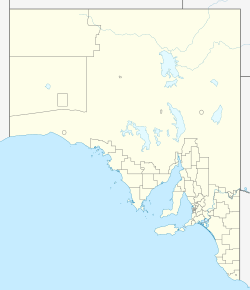Williams Island (South Australia) facts for kids
| Geography | |
|---|---|
| Location | Great Australian Bight |
| Coordinates | 35°01′50″S 135°58′30″E / 35.03056°S 135.97500°E |
| Administration | |
|
Australia
|
|
Williams Island is a special island off the coast of South Australia. It's found near the Jussieu Peninsula on the Eyre Peninsula, about 34 kilometers (21 miles) south-east of Port Lincoln.
The island was named by an explorer named Matthew Flinders in 1802. He named it after Robert Williams, a sailor who sadly died along with seven other crew members. They were searching for water when their small boat, called a cutter, flipped over. Since 2004, Williams Island has been a protected area called the Memory Cove Wilderness Protection Area. This means it's kept wild and natural.
Contents
What is Williams Island Like?
Williams Island is shaped a bit like a "U" and is about 40 meters (131 feet) tall at its highest point. It covers an area of about 141 hectares (348 acres). The island is surrounded by tall cliffs. However, there's a bay on its northern side with a sandy beach. This beach offers a safe place for boats to anchor and is the main way to get onto the island.
How Williams Island Formed
Williams Island was created around 9,100 years ago. This happened when sea levels started to rise after the last ice age.
The island's rocks tell an interesting story. It has an upper layer of a rock called calcarenite. This sits on top of a "U"-shaped ridge made of pink granite. There are also darker rocks called gneiss and dolerite that cut through the granite. The open part of the "U" shape faces the island's northern coast. This rocky ridge forms a wall of steep cliffs. Above these cliffs, the calcarenite layer starts as rocky slopes and then becomes a thick layer of soil covering most of the island.
Plants and Animals on Williams Island
Island Plants
In 1996, scientists found 26 different types of plants on Williams Island. The top part of the island is mostly covered in a type of shrubland. This means it has many bushes, especially marsh saltbush and grey saltbush. In some areas, especially near the south-east tip, you can find herbfields with plants like austral storksbill. Early visitors in 1907 said the island had no tall trees, only low, bushy saltbush.
Island Animals
An expedition in 1907, which included the famous explorer Douglas Mawson, reported that the island had many snakes. They also saw a large, scarred seal. By 1996, one mammal, 11 bird, and three reptile species were found on the island.
One important mammal is the bush rat. The black tiger snake lives on the island and hunts these bush rats. Short-tailed shearwaters, which are seabirds, use the island as a place to lay their eggs and raise their young. It's also thought that flesh-footed shearwaters might breed here. In 1907, people visiting the island also saw muttonbirds, penguins, and many small lizards. Other birds seen included the little grassbird and the Swamp hawk.
Island History
Europeans first saw Williams Island on February 20, 1802. This was from a ship called HMS Investigator, led by Matthew Flinders. He named the island that very day after Robert Williams, a sailor who tragically died the next day. Robert Williams and seven other crew members likely drowned when their small boat, a cutter, overturned near Cape Catastrophe.
In 1840, the island was surveyed by Thomas Lipson of the Royal Navy. This was part of the South Australian Government's effort to map the waters, find dangers for ships, and see if the coast was good for new settlements.
Since 1963, there has been a special light on the west side of Williams Island. This light helps ships navigate safely. It's a 6-meter (20-foot) tall tower with a flashing light. A small area of land on the island is set aside for this navigation aid, which is maintained by the Australian Maritime Safety Authority (AMSA). Helicopters are used to reach the island for maintenance work.
Protected Status
Williams Island has been part of the Memory Cove Wilderness Protection Area since September 30, 2004. Before that, it was part of the Lincoln National Park. The waters around the island are also protected as part of the Thorny Passage Marine Park.


